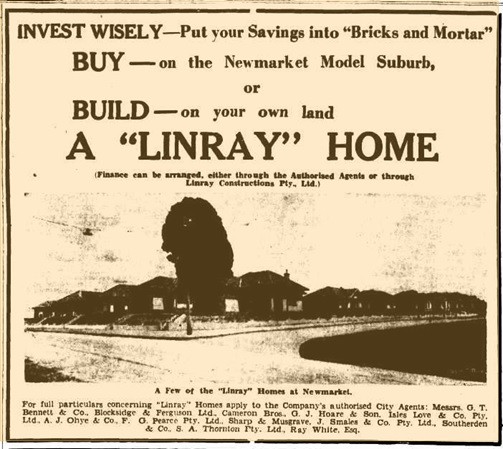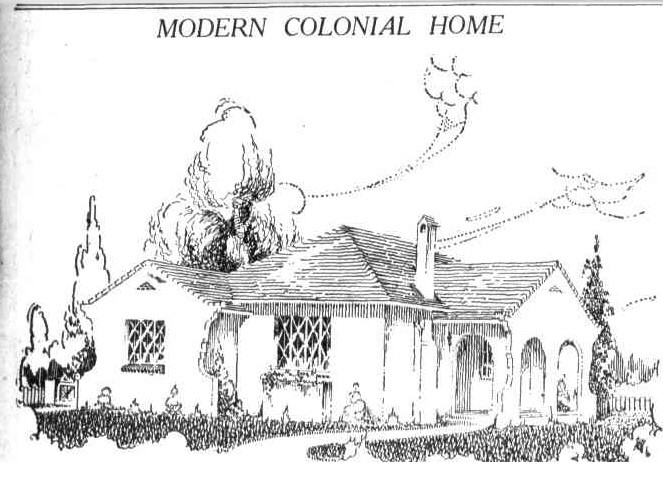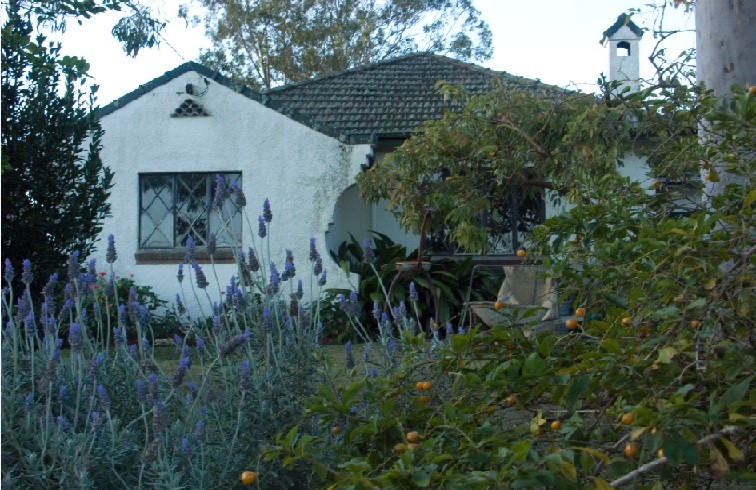The different house in the street: a lesson for today?
By Stephanie Ryan, Research Librarian, Library and Client Services | 17 August 2022
When was the house built? Who was the architect? For whom was the house built? Did the house have a name and if so, what? The phone enquirer had found her own home in Camp Hill in the Corley collection using the State Library’s catalogue, One Search, but she could not use it to find this particular, distinctive house by address. She had often wondered about the smaller, brick, neatly contoured home in a street mainly of Queenslanders.
The house was not among Frank Corley’s digitised photographs of homes, which came into State Library’s collection after his death. The photos were taken from the late 1960s to the early 1970s to sell to residents in cardboard frames. Corley retained the unsold photos to avoid paying sales tax on them. They form an impressive view of a range of Brisbane homes of all descriptions in this era, but many photos were sold and so are not in State Library’s collection. So where else?
Rarely can this common information request be answered exactly, completely, and quickly but this was the exception. A simple check of selective, indexed Queensland electoral rolls, enabling a search by address only, indicated Norman Colin Luck was the owner of the home in Stephen Street Camp Hill. He and his wife were residents there before 1941.
A search of Trove historical newspapers 1920-1941 using the surname Luck, and the address Stephen Street Camp Hill brought up items immediately answering the questions. The house was built in 1934. The architect was Arthur F W Bligh. The accompanying article to the illustration below provided the detail. The Trove hit, which followed the article, a birth notice, gave the name of the house as Casa Lita.
In an article for Quadrant online 11 May 2019, History’s Home Truths About Making Owners of Renters, Geoffrey Luck, an ABC journalist, paid tribute to his father’s astute decision to engage Bligh to build this house on a block he already owned. ‘In the depth of the Depression, my father, a humble PMG technician, had an architect build us a brick cottage in Brisbane. Brisbane! That colonial backwater of ideas, culture and design’. His father earning £4/10/- a week, paid it off in 19 years rather than 30 years by the family ‘going without things’.
The home expressed the qualities Bligh extolled: clever use of space with built-in cupboards and appliances; varied, lovely textures; effective use of bricks; and clean, beautiful proportions. In short, it was a smaller, economical, well-constructed, efficient, aesthetically pleasing home suited to the climate and available to those with smaller incomes.
The Linray project
The house had its origins in the Linray Project of 1933, a visionary model suburb project in Newmarket, during the Depression, which aimed to achieve housing and suburban standards wider Brisbane would not achieve for another 35 years. The blog, The challenge of a Brisbane ‘model suburb’ in Newmarket 1933-1935, looks at the concept, challenges and achievements of that plan. In 2013, 80 years after the project stopped, Geoffrey Luck photographed the houses that were built before the project collapsed. The collection from the University of Queensland is available digitally on Trove Images, Maps and Artefacts by searching keyword: Newmarket and Creator: Geoffrey Luck.
Interwar newspapers
Between the wars, when this house was built, all the Brisbane newspapers: Brisbane Courier, Daily Mail, later the Courier Mail, Queenslander, Telegraph, Week and Truth, ran weekly sections on homes and buildings, each with a slightly different heading. Architects and builders displayed their ideas. Fashions in building styles and interior decoration were expressed in plans, sketches and photographs. They are a great source for those exploring housing fashions, both exterior and interior, and specific homes such as the Luck’s, in the context of the time. They are free and available in Trove historical newspapers.
Magazines
Magazines also looked at building trends. These included Steering wheel and Society & home, which incorporated Steering Wheel and Society and home in Queensland Jan 1915-March 1942. These titles covered the more distinctive homes. In February 1934 there was a substantial review and illustration of the Linray Project.
- Architecture, building, engineering August 1922-February 1944 incorporated The architectural & building journal of Queensland March 1944-December 1972 also covered the interwar period.
- There are indexes to both publications in the John Oxley reading room on level 4. Of course, you will find more sources on the catalogue One Search.
- Trove Magazines & Newsletters has a variety of options from other States as well.
Geoffrey Luck in his article makes some important points about housing and the government’s role. In 1909 the Queensland Government passed An Act to enable the Government to Assist Persons in Receipt of Small Income to Provide Houses for Themselves. The workers’ dwellings which resulted ‘were not mean hovels. There was almost complete freedom in design, and the Board’s architects readily converted sketched ideas into workable plans. Styles ranged from small, low colonial cottages to many variations of the elevated houses, developed over time with return verandahs, sleepouts, and multiple gables.’
Homes for Queenslanders ‘of small means’
Judy Rechner has written extensively on these homes in her thesis Houses for Queenslanders of small means? Workers’ dwellings in old Coorparoo Shire 1910-1940. She argues in her discussion of housing styles that what happened in Coorparoo had wider application for Brisbane. Her book Brisbane house styles 1880 to 1940: a guide to the affordable house provides additional illustrations of specific features of houses over that period.
Geoffrey Luck asks:
Could innovation… be revived to build modern homes for young families more quickly or cheaply? Surely architects and builders can do better than the two-storey McMansions?
But there is more…
The picture of the Stephen Street home life seemed idyllic, but the Lucks had a tempestuous family life until they left the father who remained in his home.
This eventual acknowledgement of his father’s canniness is reminiscent of Mark Twain:
When I was a boy of 14, my father was so ignorant I could hardly stand to have the old man around. But when I got to be 21, I was astonished at how much the old man had learned in seven years.
For help with your research, visit us at State Library, or use our Ask Us service for online research assistance.
More information
Further information
Library membership - /get-involved/become-member
Ask us - /plan-my-visit/services/ask-us
Comments
Your email address will not be published.
We welcome relevant, respectful comments.


